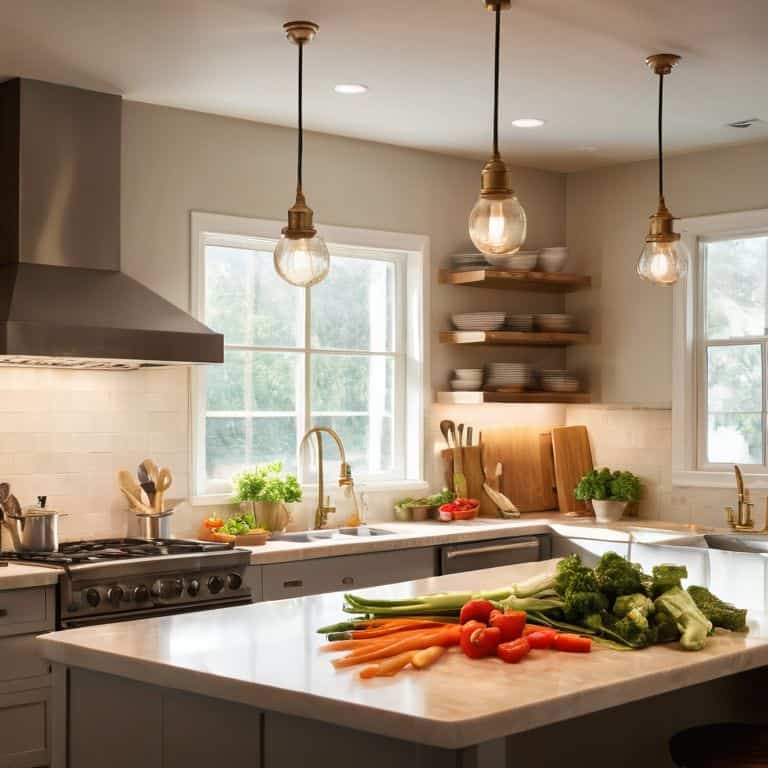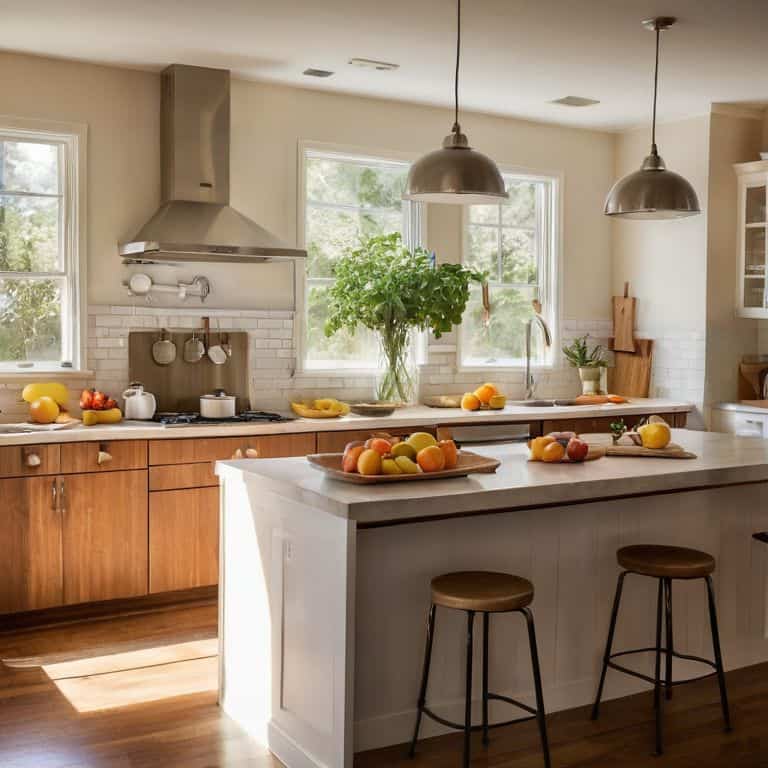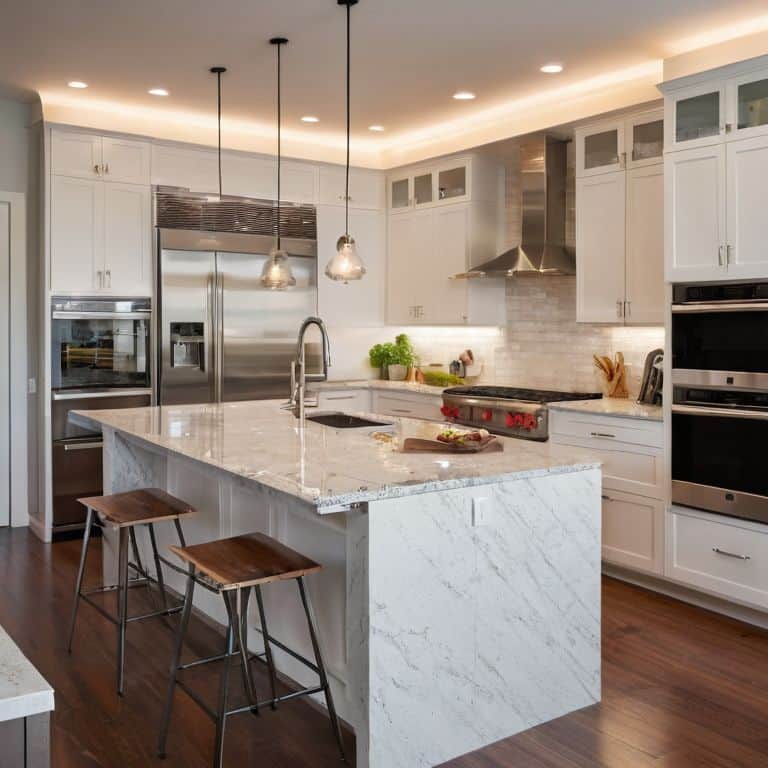I still remember the first time I walked into a kitchen with the best light temperature for a kitchen – it was like a warm hug that made me want to cook up a storm. The soft glow of the pendant lights above the island, the gentle sparkle of the under-cabinet lighting, and the natural light pouring in from the large window all combined to create a space that felt both inviting and efficient. As someone who’s passionate about creating beautiful and functional kitchens, I’ve often found myself frustrated with the overly complicated and expensive solutions that are often touted as the key to achieving this perfect ambiance.
In this article, I promise to cut through the hype and share my no-nonsense advice on how to find the best light temperature for a kitchen that works for you, regardless of your budget or style. I’ll draw on my experience as an interior designer to provide you with practical tips and real-world examples that will help you create a kitchen that’s both beautiful and functional. Whether you’re a seasoned cook or a culinary newbie, my goal is to empower you with the knowledge and inspiration you need to create a kitchen that truly feels like the heart of your home.
Table of Contents
Harmonizing Kitchen Lighting

When it comes to harmonizing kitchen lighting, I always consider the various tasks that take place in this space. From chopping vegetables to reading recipes, the right lighting can make all the difference. I’m a big fan of task lighting for kitchen counters, as it provides focused illumination exactly where you need it. This can be achieved through under-cabinet lighting or pendant lights above the island.
To create a warm and inviting ambient lighting for kitchen atmosphere, I recommend using a combination of overhead lights and table lamps. This layered approach helps to eliminate harsh shadows and creates a cozy ambiance, perfect for dinner parties or family gatherings. In terms of color temperature for kitchen tasks, I find that a warm white light (around 2700K-3000K) is ideal for most cooking tasks, as it provides a comfortable and relaxing glow.
For those looking to upgrade their kitchen lighting, I highly recommend exploring led lighting for kitchen energy efficiency. Not only do LEDs use significantly less energy than traditional lighting options, but they also come in a wide range of colors and styles to suit any kitchen design. By incorporating these kitchen lighting design tips into your space, you’ll be well on your way to creating a beautiful and functional kitchen that inspires you to cook and entertain with ease.
Ambient Lighting for Kitchen Atmosphere
When it comes to ambient lighting, I believe that _creating a warm glow_ is essential for setting the tone in your kitchen. This type of lighting is all about establishing a comfortable and inviting atmosphere, making it perfect for those cozy dinner parties or family gatherings. By using pendant lights, chandeliers, or even string lights, you can add a touch of warmth and personality to your kitchen.
To achieve the perfect ambiance, consider layering your lighting to create a sense of depth and visual interest. This can be done by combining different light sources, such as overhead lighting, table lamps, or floor lamps, to create a unique and welcoming atmosphere in your kitchen.
Task Lighting for Kitchen Counters
When it comes to task lighting for kitchen counters, I always look for fixtures that provide focused illumination. This type of lighting helps to reduce eye strain and makes food preparation a breeze. Whether you’re chopping vegetables or cooking up a storm, good task lighting can make all the difference.
For a sleek and modern look, consider installing _under-cabinet lighting_ to create a warm and inviting glow on your countertops. This type of lighting is not only functional but also adds a touch of elegance to your kitchen, making it perfect for food preparation and presentation.
Finding Best Light Temperature

When it comes to color temperature for kitchen tasks, I’ve found that it’s all about striking the right balance. A kitchen with warm and inviting lighting can make all the difference in creating a cozy atmosphere, perfect for cooking and entertaining. However, it’s also important to consider the type of tasks you’ll be performing in your kitchen, as this will help determine the ideal light temperature.
For example, if you’re doing a lot of food preparation on your kitchen counters, you may want to consider task lighting for kitchen counters with a cooler tone to help reduce eye strain. This is where LED lighting for kitchen energy efficiency comes in, offering a range of color temperatures to suit your needs. By installing under cabinet lighting options with adjustable color temperatures, you can create a flexible lighting system that adapts to your cooking style.
In my own kitchen, I’ve opted for a combination of ambient lighting for kitchen atmosphere and task lighting to create a harmonious glow. By playing with different kitchen lighting design tips, I’ve managed to find a balance that works perfectly for me. Whether I’m cooking up a storm or simply enjoying a quiet evening at home, my kitchen lighting always seems to hit the right note.
Led Lighting for Energy Efficiency
When it comes to energy efficiency, I always look to LED lighting as a top choice for my kitchen designs. Not only do LEDs use significantly less energy than traditional lighting options, but they also last much longer, reducing the need for frequent replacements. This makes them a practical and cost-effective solution for homeowners who want to reduce their environmental impact without sacrificing style or functionality.
In my own kitchen, I’ve installed LEDs with a warm white glow to create a welcoming atmosphere while still providing ample task lighting for cooking and food preparation. The result is a space that feels both energizing and inviting, perfect for whipping up a weekday dinner or hosting a weekend brunch.
Optimal Color Temperature for Kitchen Tasks
When it comes to kitchen tasks, I’ve found that the right color temperature can make a huge difference in my productivity and overall cooking experience. A cooler tone, typically around 3500K-4100K, is ideal for task-oriented areas like countertops and islands, as it provides a clear and focused light.
For more precise tasks like chopping or reading recipes, I recommend using warm white light with a color temperature around 2700K-3000K, which creates a cozy and inviting atmosphere, reducing eye strain and allowing me to focus on the task at hand.
Illuminating Insights: 5 Tips for Finding Your Kitchen's Perfect Glow
- Assess your kitchen’s natural light and consider how it impacts your artificial lighting needs, taking into account the time of day you cook most
- Experiment with layering different light sources, such as overhead lighting, under-cabinet lighting, and table lamps, to achieve a harmonious balance
- Choose a light temperature that complements your kitchen’s color palette and style, whether it’s warm and cozy or cool and modern
- Consider the 80-20 rule: 80% of your lighting should be general illumination, while 20% is task-oriented, such as under-cabinet lighting for countertops
- Don’t forget to test your lighting at different times of day and adjust as needed to ensure your kitchen remains a welcoming and functional space, no matter the hour
Key Takeaways for Your Kitchen's Perfect Glow
Illuminating your kitchen with the right light temperature can elevate your cooking experience, from precise task lighting for kitchen counters to ambient lighting that sets the mood for culinary creativity
LED lighting offers an energy-efficient solution, allowing you to achieve the optimal color temperature for various kitchen tasks, whether it’s the cool tones for food preparation or the warm tones for dining
By understanding and applying the principles of harmonious kitchen lighting, including the strategic use of light layers and temperatures, you can transform your kitchen into a space that inspires better cooking and warmer gatherings
Illuminating Insights
The right light temperature in the kitchen is not just about functionality, it’s about creating a sensory experience that nurtures both the cook and the food – it’s the unsung hero of culinary harmony!
Clara Wu
Bringing it all Together: A Brighter Kitchen Awaits

As we’ve explored the world of kitchen lighting, it’s clear that finding the best light temperature for your kitchen is a journey that combines both form and function. From task lighting that illuminates your countertops to ambient lighting that sets the mood, each element plays a crucial role in creating a space that is both beautiful and functional. We’ve also delved into the benefits of LED lighting for energy efficiency and discovered how different color temperatures can enhance or hinder your cooking experience. By understanding and applying these principles, you can transform your kitchen into a haven that inspires creativity and productivity.
As you embark on your own kitchen lighting journey, remember that the perfect glow is not just about aesthetics; it’s about harmonizing your space to nurture your passion for cooking. Whether you’re a seasoned chef or a culinary newcomer, a well-lit kitchen can be a game-changer, elevating your cooking from mundane to magical. So, go ahead, experiment with different light temperatures, and find the one that makes your kitchen – and your cooking – shine.
Frequently Asked Questions
How do I determine the ideal light temperature for my kitchen based on the specific tasks I perform most often?
To determine your ideal kitchen light temperature, consider the tasks you perform most often. If you’re a frequent cooker, warmer tones around 2700K-3000K can create a cozy atmosphere, while bakers and food preparers might prefer cooler tones around 3500K-4100K for enhanced visibility.
Will using LED lights with a high color temperature make my kitchen feel cold and uninviting?
While high-color-temperature LEDs can feel harsh, they’re perfect for task lighting. However, for ambient lighting, I recommend warmer tones to create a cozy atmosphere. Balance is key: use cool LEDs for cooking tasks and warmer lights for dining areas to create a inviting kitchen ambiance.
Can I mix different light temperatures in my kitchen, such as warm and cool tones, to create a unique ambiance?
I love experimenting with mixed light temperatures in my own kitchen. Yes, you can definitely combine warm and cool tones to create a unique ambiance. For example, warm pendant lights over the island can add coziness, while cool under-cabinet lighting can provide task-oriented brightness. It’s all about balance and harmony – play around to find the perfect blend that inspires your cooking style!
